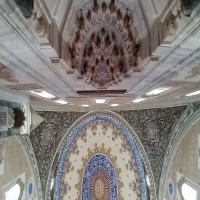Research Article
Translation
Book Review
Aim & Scope
Hitit Theology Journal aims to provide an open access academic environment where qualified scientific studies in the fields of Social Sciences, Arts and Humanities and Religious Sciences can be shared.
Subject Category:
1. Social Sciences:
Education and Educational Research
Geography
Psychology
Sociology
2. Humanities:
History
Fine Arts
Literature
Music
Philosophy
Religion
3. Religious Studies:
Tafsir
Hadith
Kalam
Tasavvuf
Islamic Philosophy
Islamic History
Keywords:
Religion
Tafsir
Qiraat
Qur'an Studies
History of Muslim Sects
Kalam
Tasavvuf
Islamic Philosophy
Psychology of Religion
Sociology of Religion
Logic
Philosophy of Religion
Religious Music
Islamic Arts
Sirah
History of Religions
Turkish Islamic Literature
Religious Education
Target Readership:
The target readers of Hitit Theology Journal is academicians, experts, researchers, undergraduate, graduate and doctoral students interested in social sciences, arts and humanities and religious sciences.
Text References:
The texts sent to the journal should be in accordance with the purpose and scope of the journal.
The submitted texts must be original, not previously published and not included in the evaluation process by another periodical.
The texts sent after the article submission date specified on the website of the journal will not be evaluated.
More than one work by an author will not be published in the same issue.
Author Guidelines
RESEARCH ARTICLE
It should not exceed 9000 words (include Abstract, Öz, Footnotes and Bibliography).
It must include sections below and need to be compiled in the following order:
1. English Title
2. Abstract (500-750 words, It should be in the range of 500-750 words. It should not exceed 750 words or 5000 characters (with spaces).
3. Keywords
4. Turkish Title
5. Öz (Turkish Abstract 500-750 words, should be in the range of 500-750 words. It should not exceed 750 words or 5000 characters (with spaces).
6. Anahtar Kelimeler (Turkish Keywords)
Arabic Title (If the article is in Arabic)
Arabic Abstract (500-750 words) (If the article is in Arabic)
Arabic Keywords (If the article is in Arabic)
7. Main Text
8. Conclusion
9. References
Öz (Turkish Abstract) and Abstract should not exceed 750 words. It should be in the range of 500-750 words. It should not exceed 750 words or 5000 characters (with spaces).
Texts need to be written in Microsoft Office Word.
Worksheets must be on A4 paper.
Margins should be left 3 cm from all sides.
It should not contain anything that gives away the identity of the author(s).
Main text must contain Introduction and Conclusion sections.
The title of the article should be arranged according to The ISNAD-2 citation style; It should be set 0 pt from the top, 6 pt from the bottom, and without recess; should be aligned to the center. It should be in Palatino Linotype font, 11 pt.
Headings should be arranged according to The ISNAD-2 citation style, It should be set as 0 pt from the top and bottom and without indent; must be aligned on both sides. Headings should be in Palatino Linotype font, 11 pt.
Main text should be written in Palatino Linotype Normal font in 10-point size; must be aligned on both sides; It should be 1.15 line spacing. Paragraph heads should be set as 1.25 cm left indented; spaces should be arranged as 0 pt above the paragraph and 6 pt below the paragraph.
Footnotes should be arranged according to The ISNAD-2 citation style.
There should be half the line between the footnote section and the main text; 10 nk space should be left above the line.
Footnotes should be written in Palatino Linotype Normal typeface 8 pt., must be aligned on both sides; must be in one-line spacing. Gaps should be set as 0 nk from the top and bottom.
Table and Figure titles and - if any - references should be written in Palatino Linotype Normal font in 8 pt., must be aligned on both sides; must be in one-line spacing. Gaps are 6 pt from the bottom, 0 pt from the top for Table and Figure descriptions; For Table and Figure resources, it should be set as 6 nk from top and bottom.
Tables should not extend beyond the writing area (page margins should not be violated), and spaces should be set as 0 pt from the top and 6 pt from the bottom. Tables smaller than the page writing area should be left-aligned.
Figures should not extend beyond the writing area (page margins should not be violated), spaces should be set as 0 pt from the top and 6 pt from the bottom. Figures smaller than the page writing area should be left-aligned.
All direct citations should be made in accordance with the ISNAD-2 citation style. If the direct quotation is a paragraph or if the article author wants to use the direct quotation as a separate paragraph, it should be written in Palatino Linotype Normal font in 10 font size; must be aligned on both sides; It should be 1 line spacing. The beginning of the paragraph should be set without the indent, the whole paragraph should be set with 2 cm indents from the left and right; spaces should be arranged as 0 pt above the paragraph and 6 pt below the paragraph.
References should be arranged according to the ISNAD-2 citation style.
References should be written in Palatino Linotype Normal font 9 pt., must be aligned on both sides; must be in one line spacing.
The first line of each reference should not be intended and the second line should be intended 1.25 cm along the left margin. Spaces should be set 0 nk above and 6 nk below each reference.
If more than one work of an author is included in the bibliography, the name of the author should be written again for each work.
Turkish abstract, Turkish keywords, abstract and keywords should be written in Palatino Linotype Normal font 9 pt., must be aligned on both sides; should be single-spaced and without indent. Keywords and keywords should be prepared according to The ISNAD-2 citation style.
Turkish abstract and abstract should contain 500-750 words. It should be 9 pt.
In articles written in a foreign language, besides the English title of the article and abstract (500-750 words), Turkish title with keywords and abstract (500-750 words) should be written.
Abbreviations should be adapted for The ISNAD-2 citation style. If abbreviations cannot be found in the ISNAD-2 citation style, the author should explain his/her preference in commands while submitting the article.
If an explanation will be made at the end of the page for the title of the article, * sign should be used.
Footer and Header entries should not be made.
Page numbers should not be included.
TRANSLATIONS
Texts need to be written in Microsoft Office Word.
Worksheets must be on A4 paper size.
Margins should be 3 cm.
It should not contain the identity of the translator(s).
The title of the translation should be the title of the piece translated.
The title should not include the name(s) of the author(s).
With the sign (*) at the end of the title, the type of the piece translated (article, book chapter, presentation etc.) and the title of the piece in ISNAD-2 citation style need to be added.
It should neither contain a header and footer nor page numbers.
Title: The ISNAD-2 citation style, centered, Palatino Linotype font, 11 point-size, not intended. 0 nk space should be set above the title and 6 nk below the title.
Headings: The ISNAD-2 citation style, Palatino Linotype font, 11 point-size, not intended, justified, 0 nk space should be set above and below the headings.
Main Text: Palatino Linotype font, 10 point-size, justified, 1,15-line space.
Paragraphs: 1,25 intended on the left side, 0 nk space above the paragraphs and 6 nk space below the paragraphs need to be set.
Regardless of the citation system used in the original text, the page-end footnote system should be used. The footnote style should be in accordance with the ISNAD-2 Citation System.
There should be half the line between the footnote section and the main text 10 nk; space should be left above the line.
Footnotes should be written in Palatino Linotype Normal typeface 8 pt., must be aligned on both sides; must be in one-line spacing. Gaps should be set as 0 nk from the top and bottom.
Table and Figure titles and - if any - references should be written in Palatino Linotype Normal font in 8 pt., must be aligned on both sides; must be in one-line spacing. Gaps are 6 pt from the bottom, 0 pt from the top for Table and Figure descriptions; For Table and Figure resources, it should be set as 6 nk from top and bottom.
Tables should not extend beyond the writing area (page margins should not be violated), spaces should be set as 0 pt from the top and 6 pt from the bottom. Tables smaller than the page writing area should be left-aligned.
Figures should not extend beyond the writing area (page margins should not be violated), spaces should be set as 0 pt from the top and 6 pt from the bottom. Figures smaller than the page writing area should be left-aligned.
All direct citations should be made in accordance with the ISNAD-2 citation style. If the direct quotation is a paragraph or if the article author wants to use the direct quotation as a separate paragraph, it should be written in Palatino Linotype Normal font in 10 font size; must be aligned on both sides; It should be 1 line spacing. The beginning of the paragraph should be set without the indent, the whole paragraph should be set with 2 cm indents from the left and right; spaces should be arranged as 0 pt above the paragraph and 6 pt below the paragraph.
References should be arranged according to the ISNAD-2 citation style.
References should be written in Palatino Linotype Normal font 9 pt., must be aligned on both sides; must be in one line spacing.
The first line of each reference should not be intended and the second line should be intended 1.25 cm along the left margin. Spaces should be set 0 nk above and 6 nk below each reference.
If more than one work of an author is included in the bibliography, the name of the author should be written again for each work.
-If any- Turkish abstract, Turkish keywords, abstract and keywords should be written in Palatino Linotype Normal font 10 pt., must be aligned on both sides; should be single-spaced and without indent. Keywords and keywords should be prepared according to The ISNAD-2 citation style.
Abbreviations should be adapted for The ISNAD-2 citation style. If abbreviations cannot be found in the ISNAD-2 citation style, the author should explain his/her preference in commands while submitting the article.
Footer and Header entries should not be made.
Page numbers should not be included.
BOOK REVIEW/SYMPOSIUM REVIEW/INTERVIEW REVIEW
It should be between 500-1500 words.
Texts need to be written in Microsoft Office Word.
Worksheets must be on A4 paper size.
Margins should be 3 cm.
The title of the review should be the title of the book reviewed in ISNAD-2 citation style.
The review title should be arranged according to the ISNAD-2 Citation System; 0 pt from the top; It should be set 6 pt from the bottom and without recess; should be aligned to the center. It should be in Palatino Linotype font, 11 pt.
Main text should be written in Palatino Linotype Normal font, 10 points size; must be aligned on both sides; It should be 1.15 line spacing. Paragraph heads should be set as 1.25 cm left indented; spaces should be arranged as 0 pt above the paragraph and 6 pt below the paragraph.
Page break footnote system should be used. The footnote style should be in accordance with the ISNAD-2 Citation System.
There should be half the line between the footnote section and the body text; 10 nk space should be left above the line.
Footnotes should be written in Palatino Linotype Normal typeface, 8 pt. must be aligned on both sides; must be in one-line spacing. Gaps should be set as 0 nk from the top and bottom.
Table and Figure titles and - if any - references should be written in Palatino Linotype Normal font in 8 pt., must be aligned on both sides; must be in one-line spacing. Gaps are 6 pt from the bottom, 0 pt from the top for Table and Figure descriptions; For Table and Figure resources, it should be set as 6 nk from top and bottom.
Tables should not extend beyond the writing area (page margins should not be violated), spaces should be set as 0 pt from the top and 6 pt from the bottom. Tables smaller than the page writing area should be left-aligned.
Figures should not extend beyond the writing area (page margins should not be violated), spaces should be set as 0 pt from the top and 6 pt from the bottom. Figures smaller than the page writing area should be left-aligned.
All direct citations should be made in accordance with the ISNAD-2 citation style. If the direct quotation is a paragraph or if the article author wants to use the direct quotation as a separate paragraph, it should be written in Palatino Linotype Normal font in 10 font size; must be aligned on both sides; It should be 1 line spacing. The beginning of the paragraph should be set without the indent, the whole paragraph should be set with 2 cm indents from the left and right; spaces should be arranged as 0 pt above the paragraph and 6 pt below the paragraph.
References should be arranged according to the ISNAD-2 citation style.
References should be written in Palatino Linotype Normal font 9 pt., must be aligned on both sides; must be in one line spacing.
The first line of each reference should not be intended and the second line should be intended 1.25 cm along the left margin. Spaces should be set 0 nk above and 6 nk below each reference.
If more than one work of an author is included in the bibliography, the name of the author should be written again for each work.
-If any- Turkish abstract, Turkish keywords, abstract and keywords should be written in Palatino Linotype Normal font 10 pt., must be aligned on both sides; should be single-spaced and without indent. Keywords and keywords should be prepared according to The ISNAD citation style.
Abbreviations should be adapted for The ISNAD-2 citation style. If abbreviations cannot be found in the ISNAD-2 citation style, the author should explain his/her preference in commands while submitting the article.
If an explanation will be made at the end of the page for the title of the evaluation, * mark should be used.
Footer and Header entries should not be made.
Page numbers should not be included.
Ethical Principles and Publication Policy
Ethical Principles
The publication process in the Hittite Theology Journal was created to develop and present information objectively. For this reason, the processes applied to reflect the quality of the authors and the quality of the institutional work that supports the authors. The articles reviewed embody and encourage the scientific method. In this respect, it is important that all stakeholders of the process (authors, readers and researchers, publishers, referees and editors) comply with the standards regarding ethical principles.Hitit Theology Journal expects all stakeholders to bear the ethical responsibilities described below within the scope of publication ethics.
The ethical duties and responsibilities adopted by the Hitit Theology Journal have been prepared by taking into account the Committee on Publication Ethics (COPE) guidelines and policies.
Actions contrary to scientific research and publication ethics:
Plagiarism: Presenting others’ ideas, methods, data, practices, writing, forms or studies partly or wholly without referencing to the owners according to scientific rules,
Forgery: Producing data that is not based on research, editing or changing the presented or published study by basing it on fictitious data, reporting or publishing these, claiming research has been done while actually it has not,
Distortion: Falsifying the obtained data and the research records, showing the methods, devices and materials that were not used in the study as if they had been used, not taking the data that is not suitable to the research hypothesis into consideration, changing the data and/or results to make them be appropriate to the related theory and presuppositions, falsifying or manipulating the research results in accordance with the advantages of the people and the institutions that support the researcher,
Re-publishing: To present more than one work containing the same results of a research separately in evaluations for associate professorship exams and academic promotions,
Dissection: Dissecting the results of a study in a way that would destroy the integrity of the study and inappropriately, publishing them separately without referencing each study, thus increasing the number of publications to present them in associate professorship exam evaluations and academic promotions,
Undeserved Authorship: Including those who don’t have an active contribution among authors, not including those who have an active contribution among authors, changing the ranking of authors without a reason and inappropriately, excluding the names of those with active contribution from the study during publication or in next publications, making one’s name included – by exerting influence – in authors despite having no active contribution,
Other Types of Violation of Ethics: Not naming the people, institutions and organizations and their contributions to the study openly in the publication of the research made by the support of those, not following the ethical rules in studies done on humans or animals, not respecting the rights of patients in the publications, sharing the contents of a study appointed as referee before its publication, using the sources, places, opportunities and devices provided for scientific researches out of their purposes, accusing someone of violation of ethics in a baseless, injudicious and malicious way.
Ethical Statement
• Ethical rules must be complied with in the studies conducted on humans and animals.• It should be stated that the copyright regulations are complied with for the intellectual and artistic works used.
• Necessary permissions must be obtained to use others' scale, questionnaires, photographs, etc. and stated.
• In the case of studies, an "informed consent form" should be obtained and stated.
• If the research has been conducted in the fields listed below, it is mandatory to upload an “Ethics Committee Approval” in the annex of the study.
Studies Requiring Ethics Committee Approval
• All kinds of research conducted with qualitative or quantitative approaches that require data collection from participants using questionnaires, interviews, focus group work, observation, experimentation,• Use of humans and animals (including material/data) for experimental or other scientific purposes,
• Clinical studies on humans
• Clinical studies on animals,
• Retrospective studies in accordance with the law on the protection of personal data.
Publication of research that involve human subjects (i.e., surveys and interviews)
Hitit Theology Journal adopts the "Code of Conduct and Best Practice Guidelines for Journal Editors" and "Code of Conduct for Journal Publishers" of the Publication Ethics Committee (COPE) in order to create ethical assurance in scientific periodicals. In this context, the following points should be followed in the manuscripts submitted to the journal:
1) For research conducted in all branches of science that requires ethics committee approval (ethics committee approval should be obtained, this approval should be stated and documented in the article.
2) In research that requires ethics committee permission, information about the permission (name of the committee, date, and number) is in the method section, and also on one of the first/last pages of the article; In case of reports, information about signing the informed consent/consent form should be included in the article.
Responsibilities of Writers
• Article Writing
All authors cited as research writers must contribute to the research substantially. Other contributors should be listed as co-authors. Contributors to the research should be mentioned as 'contributors'. The corresponding author should take the consent of other authors before sending the study to the journal. Those who do not have a direct contribution to the research should not be listed as authors.• Originality and Authenticity
All data in the study must be true and original. The author should present an objective discussion of the importance of his work based on accurate data. Intentionally presenting false information is unacceptable and unethical behavior.• Multiple, Unnecessary and Simultaneous Publishing
The author should not attempt to publish the same research in more than one journal, or attempt to republish a previously published article, and should comply with scientific research and publication ethics. Such attempts are unacceptable unethical behaviors.• Resources
It is mandatory to show / cite all sources used in the study.• Disclosure and Conflict of Interest
All authors must clearly state any potential financial and interest conflicts that may affect the results of the study. If financial support has been received for the study, its sources should be indicated.• Publishing Fee
No fee is charged from the authors for any research published in our journal.• Correction of Published Studies
It is the author's responsibility to inform the editor if any significant deficit or mistake is detected in the published work. The author should cooperate with the editorial team of our journal in order to take the necessary actions to correct the situation.• Withdrawal of the Article
The author can only withdraw the work evaluated in the publishing processes at the pre-check stage. Works cannot be withdrawn at other stages of the publishing process.• Originality and Plagiarism
Authors should aim to make original research and report. The mentioned literature should be appropriately cited. Uncited mentions from other publications, including the author's own work, are an important moral issue and a crime. If plagiarism is detected in the articles submitted to our journal, they are removed from the publication processes immediately. If it detected after publication, immediate action is going to be taken about the author and the article.• Double-Blind Refereeing
As double-blind refereeing is applied in our journal, author information should not be written in the article file.Responsibilities of Referees
• Contribution to the Editorial Decision
The referee is obliged to consult the "Referee Evaluation Criteria" in the evaluation process from the moment they are appointed and accepted the task through the system. The referee assists editors with their editorial decisions and assists authors in improving their articles through editorial communication. The referee should point out the completion of other articles, works, references, citations, rules and similar shortcomings related to the article.• Abiding by the Schedule
Any referee who does not feel qualified to review the article proposal or knows that the article review cannot take place on time should immediately notify the editors and decline the invitation to review, thereby ensuring that the new referee assignment is made.• Confidentiality
Articles reviewed should be kept confidential before publication.Referees acknowledge that the work submitted for their review is the private property of the authors. This also applies to referees who decline their invitation to review.
The names of the referees are not disclosed / published.
• Objectivity
Referees should be objective in the decision to publish the text they examine.Comments on the text should be made impartially and recommendations should be made in a way that the authors can use to improve the text.
Personal criticism of the authors is not appropriate.
• Resources
The referee should identify relevant published work that is not cited by the authors. The referee should also inform the editor of any significant similarities between the article reviewed and any other article(published or unpublished).• Conflict of Interest
Conflicts of interest should be reported to the editor. There should be no conflict of interest between the referees and the stakeholders of the article under review. In case of any conflict of interest and an appointment outside of the field of expertise, it is recommended to present the situation to the editor and withdraw from the referee process if necessary.• Ethics
Should the referees notice any ethical violation, plagiarism, etc. they should inform the editor. Referees acknowledge that the work submitted for review is the private property of the authors.Editorial Responsibilities
• The Editorial Board have all the responsibility and authority to accept or decline an article.• The Editorial Board should not be in a conflict of interest about the articles they accepted or declined.
• In the publication process, studies are selected and evaluated according to scientific and academic criteria such as contribution to the field and originality.
• The Editorial Board ensures publication of a correction or withdrawal in case of a mistake or an incompleteness detected in a published article.
• Since double-blind refereeing is adopted in the journal, the names of the referees are kept confidential and not published.
• The refereeing process is at the center of the success of scientific publishing. It is part of our commitment to maintain and improve the referee process.
• Hitit Theology Journal takes the necessary precautions carefully in cases of violation of publishing ethics.
• All kinds of complaints and suggestions regarding the studies published in Hitit Theology Journal, publication processes and editorial team can be sent to the address ilafdergi@hitit.edu.tr.
• Any feedback from stakeholders is considered an important contribution to R&D studies.
Publication Language
• The publication language of the Hitit Theology Journal is Turkish. In addition, scientific studies in Arabic and English are also published.Publication Principles
• All control and evaluation processes of the texts are reported and archived in Dergipark.• Acceptance dates for all text types are in between 15 Jan-15 Feb for the June issue and 1 June -15 Aug for the December issue. The article submission system is closed except for this date range.
• The texts that are not adjusted according to the Writing Rules are returned to the author without being taken into the evaluation process.
• Hitit Theology Journal publishes texts that was not previously published elsewhere.
• Texts that are in the evaluation process for another journal are returned to the author.
• Hitit Theology Journal publishes texts related to the field of divinity. The interdisciplinary texts related to the field of divinity can also be taken into the evaluation process by taking their contributions to the field into account.
• No more than one (1) study of an author can be published in the same issue regardless of the text type.
• Up to two (2) studies can be published in the same volume, provided that the publication type is different.
• Those who are in the editorial board of the journal can send text to the journal, but they cannot work in the journal at the time the text is evaluated.
Publication Policies
• Hitit Theology Journal, besides publishing qualified scientific research, has made it a mission to contribute to the author and academic journalism besides publishing qualified scientific research.
• The Publishing Processes carried out by the Editorial team, experts in their fields, have been determined in line with this mission.
• Hitit Theology Journal is the publication organ of Hitit University Faculty of Theology.
• Hitit Theology Journal is an international peer-reviewed journal.
• Hitit Theology Journal is published in print and electronic media.
• Hitit Theology Journal is published twice a year, as one volume two issues, December and June.
• In Hitit Theology Journal, all policies and processes are decided by the editorial board.
• Special issues can be published with the decision of the editorial board.
• Changes to journal publishing policies and processes are announced on the journal's official website.
• Hitit Theology Journal has an original 6-step Publishing Process. Each stage in the publishing process is carried out according to specific evaluation criteria within the framework of defined job descriptions and workflows.
Evaluation Policies
Articles and translations are subjected to two types of evaluation:Structural Evaluation
• Writing Control: The texts are examined in terms of shape, writing rules and compliance with the ISNAD-2 Citation System. Authors should make the corrections within 11 days.
• Plagiarism/Similarity Control: Texts are examined in terms of plagiarism/similarity rate. The plagiarism/similarity rate determined by the Editorial Board is 15%. Articles exceeding this rate are rejected without being included in the referee process.
• Language Control: For Turkish texts, the Abstract section, and for texts written in other languages, the Abstract, and Öz sections are grammatically checked.
• Revision and Proofreading: In order to ensure the unity in linguistic expression and writing style, necessary corrections are made to the language and style of the text without interfering with the content and within the knowledge of the author. After this stage, no correction is requested from the author, but the text is sent to the author for the final reading.
Academic Evaluation
• Editorial Board Evaluation
• Taking the field of the text into account, each article is sent to two editorial board members by the editor.• Editorial Board members examine and evaluate the studies according to the Editorial Board Evaluation Criteria within the framework of a double-blind evaluation system and make referee recommendations.
• The articles reviewed and evaluated by the Editorial Board are subjected to a score ranking, and the first 25 articles are included in the evaluation process.
For the Book and Symposium Reviews, the evaluation is made by the editor of the field assigned by the editor.
• Referee Evaluation:
• The texts are subjected to academic evaluation by the referees determined by the editorial board. In the referee evaluation process, the text is sent to the author for corrections if the referee requests it. The author must fill in the Author Correction Form along with the corrected text.• If the texts receive positive reports from both referees, they are submitted to the Editorial Board is submitted to its final decision.
Texts with a negative report by one referee are returned to the author, even if the other is positive.
• It is important that the authors do not exceed the dates given for corrections in order for the journal publishing process to function properly. The texts of the authors who do not make corrections within the specified dates are removed from the evaluation process.
Referee Policy
• In Hitit Theology Journal double-sided blind refereeing system is applied.• Confidentiality is essential in the referee reports; therefore, referee names are not mentioned in the journal.
• Multiple articles can be sent to a referee.
Special Issue Publication Policy
A special issue can be published once a year upon the decision of the Editorial Board. Articles submitted for publication in the special issue are subject to the publication processes of the journal.
As in the regular issue, the journal's publication processes (Editorial Board Evaluation (double-blind), Spelling and Plagiarism Control, Referee Evaluation (double-blind), Language Control, and Proofreading) are applied in the special issue.
Archive Policy• The journal is sent to the domestic and foreign libraries determined by the Editorial Board and to international index institutions within one month from the date of publication.
Copyright Policy
• From the date of its submission to the Journal of Divinity Faculty Hitit University until the end of the evaluation process and if it is published from the publication date, the translation cannot be published entirely or partially in any form of visual, auditory and printed media without the consent of the Editorial Board of Hitit Theology Journal; it can be quoted by referring to Hitit Theology Journal.Plagiarism Policy
• The plagiarism/similarity rate determined by the Editorial Board is 15%. Articles exceeding this rate are rejected without being included in the referee process.• During the plagiarism check, the field editor uses Turnitin produced for plagiarism/similarity control and presents the results to the editor in a report.
Fiscal Policy
• Hitit Theology Journal is an open-access journal; no fee is charged for access.• The authors are not paid any fees for their published works.
• The editorial board and referees are not paid any fees.
• All financial and legal copyright transactions of the translations are done by the translator.
• No financial support is provided to the translator for copyright and any other charges.
• The author is deemed to have accepted all financial, legal and scientific responsibility since the date the translated text is submitted to the Hitit Theology Journal.
Price Policy
• Hitit Theology journal is an open-access journal, no fee is charged.
• No fee is paid to the author for the published texts.
• No fee is paid to the editorial board and referees.
• The translator does all financial and legal copyright transactions of translations.
• No financial support is provided to the translation owner for copyright and other fees.
• The author is deemed to have accepted all financial, legal, and scientific responsibility for sending the translation to the Hitit Theology Journal.
Indexes
Citation Indexes
Other Indexes
Journal Boards
Publication Coordinator

Editor in Chief

Issue Editor

Vice Editor

Editorial Board




























 Web
Web




 Web
Web











Ethic Editor

 Web
Web
Field Editors








Language Editors


Redactors




Layout Editor

Hitit Theology Journal is licensed under a Creative Commons Attribution 4.0 International License (CC BY NC).












